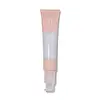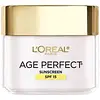What's inside
What's inside
 Key Ingredients
Key Ingredients

 Benefits
Benefits

 Concerns
Concerns

 Ingredients Side-by-side
Ingredients Side-by-side

Octocrylene 7.1%
UV AbsorberWater
Skin ConditioningButylene Glycol
HumectantC12-15 Alkyl Benzoate
AntimicrobialGlycerin
HumectantGlyceryl Stearate
EmollientPEG-100 Stearate
Mica
Cosmetic ColorantCetearyl Olivate
Cyclopentasiloxane
EmollientSorbitan Olivate
EmulsifyingStearic Acid
CleansingCetearyl Alcohol
EmollientDimethicone
EmollientTocopheryl Acetate
AntioxidantCocos Nucifera Oil
MaskingButyrospermum Parkii Butter
Skin ConditioningHydrolyzed Hyaluronic Acid
HumectantPhenoxyethanol
PreservativeCaprylyl Glycol
EmollientAcrylates/Polytrimethylsiloxymethacrylate Copolymer
Skin ConditioningAcrylates/C10-30 Alkyl Acrylate Crosspolymer
Emulsion StabilisingTromethamine
BufferingParfum
MaskingDisodium EDTA
Bisabolol
MaskingSynthetic Fluorphlogopite
Silica
AbrasiveTin Oxide
AbrasiveCI 77891
Cosmetic ColorantCI 16035
Cosmetic ColorantCI 19140
Cosmetic ColorantOctocrylene 7.1%, Water, Butylene Glycol, C12-15 Alkyl Benzoate, Glycerin, Glyceryl Stearate, PEG-100 Stearate, Mica, Cetearyl Olivate, Cyclopentasiloxane, Sorbitan Olivate, Stearic Acid, Cetearyl Alcohol, Dimethicone, Tocopheryl Acetate, Cocos Nucifera Oil, Butyrospermum Parkii Butter, Hydrolyzed Hyaluronic Acid, Phenoxyethanol, Caprylyl Glycol, Acrylates/Polytrimethylsiloxymethacrylate Copolymer, Acrylates/C10-30 Alkyl Acrylate Crosspolymer, Tromethamine, Parfum, Disodium EDTA, Bisabolol, Synthetic Fluorphlogopite, Silica, Tin Oxide, CI 77891, CI 16035, CI 19140
Phenylbenzimidazole Sulfonic Acid 1.7%
UV AbsorberEthylhexyl Methoxycinnamate 7.5%
UV AbsorberWater
Skin ConditioningCyclopentasiloxane
EmollientGlycerin
HumectantParaffinum Liquidum
EmollientMyristyl Myristate
EmollientStearic Acid
CleansingTriethanolamine
BufferingPalmitic Acid
EmollientAmmonium Polyacryloyldimethyl Taurate
Emulsion StabilisingTitanium Dioxide
Cosmetic ColorantPEG-100 Stearate
Glyceryl Stearate
EmollientMannitol
HumectantPEG-20 Stearate
EmulsifyingStearyl Alcohol
EmollientPhenoxyethanol
PreservativeTocopheryl Acetate
AntioxidantPanthenol
Skin ConditioningCetyl Alcohol
EmollientCapryloyl Salicylic Acid
ExfoliatingAcrylates Copolymer
Butylene Glycol
HumectantAlumina
AbrasiveCyclodextrin
AbsorbentYeast Extract
Skin ConditioningSoluble Collagen
HumectantDisodium Succinate
MaskingScutellaria Baicalensis Root Extract
AstringentMorus Bombycis Root Extract
Skin ConditioningDiazolidinyl Urea
PreservativeMethylparaben
PreservativeButylparaben
MaskingDisodium EDTA
Parfum
MaskingPhenylbenzimidazole Sulfonic Acid 1.7%, Ethylhexyl Methoxycinnamate 7.5%, Water, Cyclopentasiloxane, Glycerin, Paraffinum Liquidum, Myristyl Myristate, Stearic Acid, Triethanolamine, Palmitic Acid, Ammonium Polyacryloyldimethyl Taurate, Titanium Dioxide, PEG-100 Stearate, Glyceryl Stearate, Mannitol, PEG-20 Stearate, Stearyl Alcohol, Phenoxyethanol, Tocopheryl Acetate, Panthenol, Cetyl Alcohol, Capryloyl Salicylic Acid, Acrylates Copolymer, Butylene Glycol, Alumina, Cyclodextrin, Yeast Extract, Soluble Collagen, Disodium Succinate, Scutellaria Baicalensis Root Extract, Morus Bombycis Root Extract, Diazolidinyl Urea, Methylparaben, Butylparaben, Disodium EDTA, Parfum
 Reviews
Reviews

Ingredients Explained
These ingredients are found in both products.
Ingredients higher up in an ingredient list are typically present in a larger amount.
Butylene Glycol (or BG) is used within cosmetic products for a few different reasons:
Overall, Butylene Glycol is a safe and well-rounded ingredient that works well with other ingredients.
Though this ingredient works well with most skin types, some people with sensitive skin may experience a reaction such as allergic rashes, closed comedones, or itchiness.
Learn more about Butylene GlycolCyclopentasiloxane, or D5, is a silicone used to improve texture of products and trap moisture.
D5 is considered lightweight and volatile. Volatile means it evaporates quickly after application. Once evaporated, D5 leaves a thin barrier that helps keep skin hydrated.
It is also an emollient. Emollients help soften the skin and prevent water loss. Silicones create a silky texture in products. D5 helps other ingredients become more spreadable.
Studies show D5 is safe to use in skincare products. We recommend speaking with a skincare professional if you have concerns.
Learn more about CyclopentasiloxaneDisodium EDTA plays a role in making products more stable by aiding other preservatives.
It is a chelating agent, meaning it neutralizes metal ions that may be found in a product.
Disodium EDTA is a salt of edetic acid and is found to be safe in cosmetic ingredients.
Learn more about Disodium EDTAGlycerin is already naturally found in your skin. It helps moisturize and protect your skin.
A study from 2016 found glycerin to be more effective as a humectant than AHAs and hyaluronic acid.
As a humectant, it helps the skin stay hydrated by pulling moisture to your skin. The low molecular weight of glycerin allows it to pull moisture into the deeper layers of your skin.
Hydrated skin improves your skin barrier; Your skin barrier helps protect against irritants and bacteria.
Glycerin has also been found to have antimicrobial and antiviral properties. Due to these properties, glycerin is often used in wound and burn treatments.
In cosmetics, glycerin is usually derived from plants such as soybean or palm. However, it can also be sourced from animals, such as tallow or animal fat.
This ingredient is organic, colorless, odorless, and non-toxic.
Glycerin is the name for this ingredient in American English. British English uses Glycerol/Glycerine.
Learn more about GlycerinGlyceryl Stearate is a mix of glycerin and stearic acid.
It is used to stabilize the mixing of water and oil ingredients. By preventing these ingredients from separating, it can help elongate shelf life. It can also help thicken the product's texture.
As an emollient, it helps soften skin and supports barrier-replenishing ingredients.
In cosmetics, Glyceryl Stearate is often made from vegetable oils or synthetically produced.
This ingredient may not be fungal-acne safe
Fun fact: The human body also creates Glyceryl Stearate naturally.
Learn more about Glyceryl StearateParfum is a catch-all term for an ingredient or more that is used to give a scent to products.
Also called "fragrance", this ingredient can be a blend of hundreds of chemicals or plant oils. This means every product with "fragrance" or "parfum" in the ingredients list is a different mixture.
For instance, Habanolide is a proprietary trade name for a specific aroma chemical. When used as a fragrance ingredient in cosmetics, most aroma chemicals fall under the broad labeling category of “FRAGRANCE” or “PARFUM” according to EU and US regulations.
The term 'parfum' or 'fragrance' is not regulated in many countries. In many cases, it is up to the brand to define this term.
For instance, many brands choose to label themselves as "fragrance-free" because they are not using synthetic fragrances. However, their products may still contain ingredients such as essential oils that are considered a fragrance by INCI standards.
One example is Calendula flower extract. Calendula is an essential oil that still imparts a scent or 'fragrance'.
Depending on the blend, the ingredients in the mixture can cause allergies and sensitivities on the skin. Some ingredients that are known EU allergens include linalool and citronellol.
Parfum can also be used to mask or cover an unpleasant scent.
The bottom line is: not all fragrances/parfum/ingredients are created equally. If you are worried about fragrances, we recommend taking a closer look at an ingredient. And of course, we always recommend speaking with a professional.
Learn more about ParfumPeg-100 Stearate is an emollient and emulsifier. As an emollient, it helps keep skin soft by trapping moisture in. On the other hand, emulsifiers help prevent oil and water from separating in a product.
PEGS are a hydrophilic polyether compound . There are 100 ethylene oxide monomers in Peg-100 Stearate. Peg-100 Stearate is polyethylene glycol ester of stearic acid.
Phenoxyethanol is a preservative that has germicide, antimicrobial, and aromatic properties. Studies show that phenoxyethanol can prevent microbial growth. By itself, it has a scent that is similar to that of a rose.
It's often used in formulations along with Caprylyl Glycol to preserve the shelf life of products.
Stearic Acid is a fatty acid. It is an emollient, emulsifier, and texture enhancer.
As an emollient, stearic acid helps soften skin. It aids the skin's protective barrier by preventing water loss. It also provides a gentle cleansing effect without stripping away natural oils.
Stearic acid may also be used to enhance the texture of products. It can add volume and stabilize ingredients such as water and oil. This can help water and oil ingredients from separating.
Sources of stearic acid include animal or vegetable fats/oils such as coconut or shea. It can be naturally found in butter, cocoa butter, shea butter, vegetable fats, and animal tallow.
This ingredient may not be Malassezia folliculitis, or fungal-acne safe.
Learn more about Stearic AcidTocopheryl Acetate is AKA Vitamin E. It is an antioxidant and protects your skin from free radicals. Free radicals damage the skin by breaking down collagen.
One study found using Tocopheryl Acetate with Vitamin C decreased the number of sunburned cells.
Tocopheryl Acetate is commonly found in both skincare and dietary supplements.
Learn more about Tocopheryl AcetateWater. It's the most common cosmetic ingredient of all. You'll usually see it at the top of ingredient lists, meaning that it makes up the largest part of the product.
So why is it so popular? Water most often acts as a solvent - this means that it helps dissolve other ingredients into the formulation.
You'll also recognize water as that liquid we all need to stay alive. If you see this, drink a glass of water. Stay hydrated!
Learn more about Water